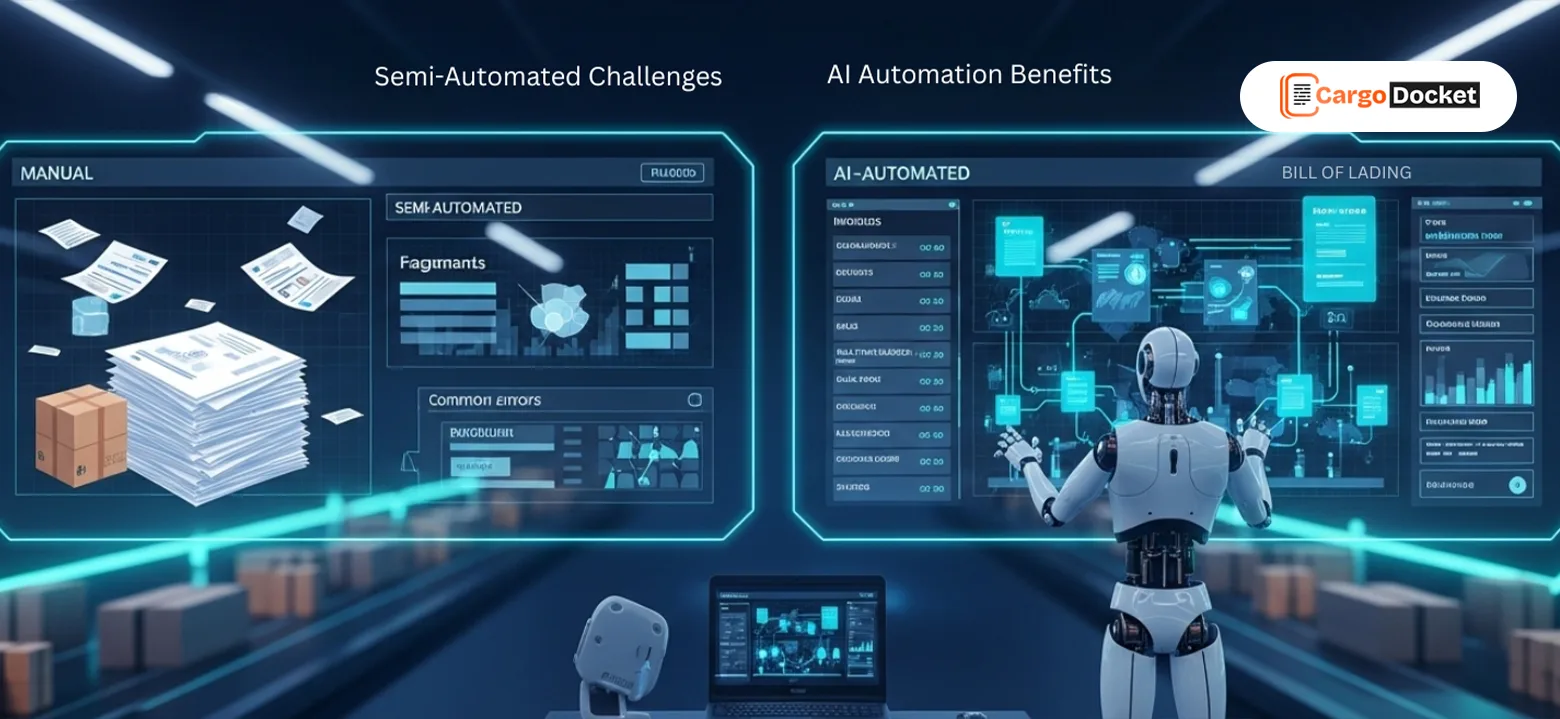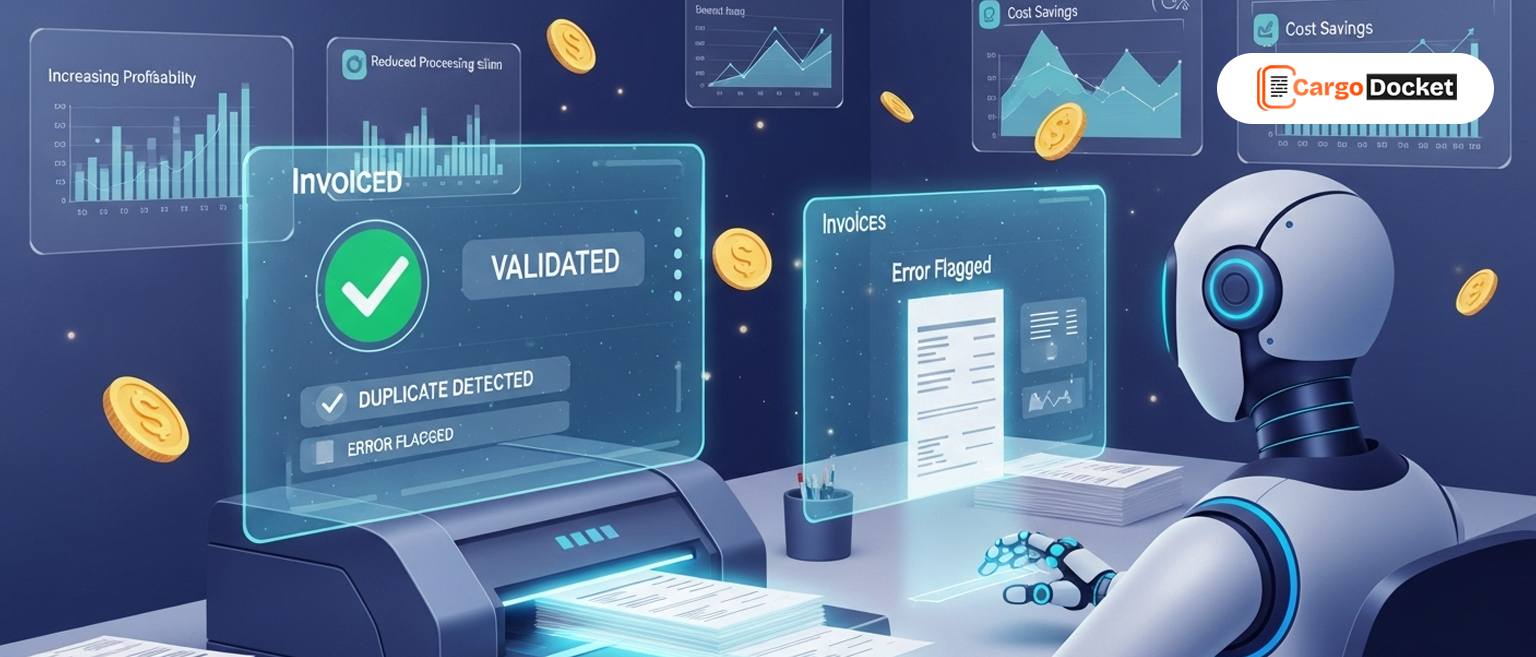When you’re in logistics, freight forwarding, or any supply chain-related business, documentation isn’t just part of the job. It’s the job. Invoices, Bills of Lading, packing lists, customs paperwork, your operations generate thousands of documents every week. And with each one comes the tedious process of manually reviewing, entering, and validating data.
This volume of paperwork doesn’t just consume time, it exposes your business to costly delays, human error, and compliance risks. In an industry where every minute and every data point counts, manual document handling is no longer sustainable.
That’s where Intelligent Document Processing (IDP) comes in. Unlike traditional document automation tools that rely on rigid templates, IDP uses artificial intelligence to understand and process documents much like a human would, but faster, more accurately, and at scale. For logistics professionals striving to simplify operations and scale efficiently, IDP offers more than automation. It offers a smarter way of working.
What is Intelligent Document Processing?
Intelligent Document Processing, or IDP, is the next generation of document automation technology. It combines multiple AI technologies, like machine learning (ML), natural language processing (NLP), and robotic process automation (RPA), to extract, interpret, and validate data from documents, even if they’re unstructured or messy.
Where traditional OCR systems rely on pre-set templates and positional rules to extract information, IDP understands context. It can scan an invoice from one vendor today, process a completely different format tomorrow, and still extract the same key data points, without needing manual template updates.
IDP is designed to handle real-world complexity. It works on scanned PDFs, Excel files, images, emails, and even handwritten forms. Whether you’re dealing with a standardized Air Waybill or a non-uniform Bill of Lading, IDP “reads” the content, identifies what’s important, and captures it accurately. More importantly, it learns and improves with every document it processes.
In logistics, this level of intelligence is crucial. With multiple carriers, international vendors, fluctuating documentation styles, and regulatory nuances, a flexible and adaptive solution like IDP becomes indispensable.
How does Intelligent Document Processing Work?
Although IDP uses advanced AI document automation under the hood, the process itself is surprisingly straightforward from the user’s perspective. Here’s how it typically works in a logistics environment:
1. Document Ingestion
The system begins by collecting documents from multiple sources, emails, shared folders, web portals, or document management systems. Whether it’s a scanned paper invoice, a digital customs declaration, or an Excel-based packing list, IDP accepts it.
2. Preprocessing and Image Optimization
To ensure high accuracy, the system enhances the document image. It may rotate pages, remove smudges, straighten text, and adjust contrast, especially useful for scanned or low-quality documents.
3. Document Classification
The system identifies what type of document it is. Is it a freight invoice? A Bill of Lading? A delivery note? Through machine learning and pattern recognition, IDP classifies documents automatically, even when naming conventions or layouts vary.
4. Data Extraction
Using AI and NLP, the IDP engine extracts the required data fields, like invoice numbers, amounts, HS codes, Incoterms, shipping dates, line items, and currency details. Unlike traditional systems, it doesn’t need pre-defined templates. It “understands” the data and knows where to look based on context, not just position.
5. Validation and Cross-Referencing
IDP validates the extracted data against your ERP or TMS records, like CargoWise, SAP, or Oracle. For example, it might check that the PO number exists or that the shipment amount matches the system accruals. Any discrepancies are flagged for review.
6. Data Integration
Once validated, the structured data is automatically pushed into your ERP, TMS, billing system, or financial platform, eliminating the need for manual data entry.
Benefits of Intelligent Document Processing
1. Significant Time Savings
IDP can reduce manual data entry efforts by 80–90%, allowing your operations and finance teams to shift focus from repetitive admin to higher-value tasks. What used to take hours can now be done in minutes.
2. Improved Accuracy
Human error is inevitable with manual work. IDP consistently delivers high-quality, validated data, reducing costly mistakes, incorrect billing, and compliance headaches.
3. Real Scalability
Whether you’re processing a few hundred documents a week or tens of thousands during peak season, IDP scales effortlessly without adding headcount.
4. Built-in Compliance and Audit Trails
Every document processed is automatically logged, validated, and archived. This improves audit readiness and supports regulatory compliance for customs, finance, and trade reporting.
5. End-to-End System Integration
IDP integrates with CargoWise, QuickBooks, SAP, and other leading systems. This means real-time updates, fewer delays, and smoother operations across departments.
6. Long-Term Cost Reduction
By eliminating the need for manual entry teams or third-party data entry (like BPO services), IDP reduces operational costs and increases ROI with every document it processes.
What’s the Difference Between Intelligent Document Processing and Automated Document Processing?
Although the terms are sometimes used interchangeably, there is a clear distinction between Intelligent Document Processing (IDP) and Automated Document Processing (ADP).
Automated Document Processing typically refers to legacy systems that use OCR combined with rule-based templates to extract data. These systems require you to define exactly where each field appears on a document. If a supplier changes their invoice format or a shipping document’s layout shifts, the system may fail, requiring manual intervention or reconfiguration.
IDP, however, doesn’t rely on fixed templates. It reads and understands document content using machine learning and natural language understanding. This allows it to adapt in real-time to document variations and extract data regardless of layout or language. IDP is self-learning, it improves as it processes more documents, making it more reliable and scalable than ADP.
In essence, ADP automates data entry, but only for predictable, structured documents. IDP delivers true document intelligence, automating not just extraction, but validation, learning, and integration. It’s designed for the real world, where document formats change, volumes fluctuate, and accuracy can’t be compromised.
Conclusion
In today’s global logistics and freight forwarding landscape, managing documentation efficiently is no longer just a back-office challenge, it’s a strategic necessity. As trade volumes increase and operational demands intensify, the limitations of manual entry and outdated OCR-based automation are becoming painfully clear.
Intelligent Document Processing (IDP) is not just a technology upgrade, it’s a smarter approach to how your business handles its most essential workflows. From improving accuracy and speeding up processes to reducing costs and ensuring compliance, IDP empowers your team to work smarter, not harder.
Are you ready to remove manual document confusion from your logistics operations? To find out how our AI-powered document processing solutions can work with your current systems and begin generating a return on investment in weeks rather than months, schedule a free consultation with Cargo Docket AI right now.




